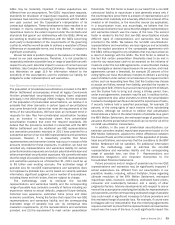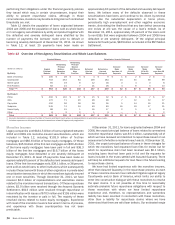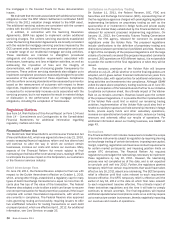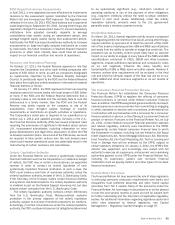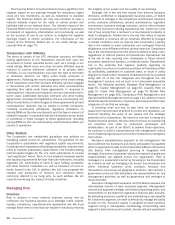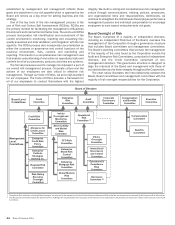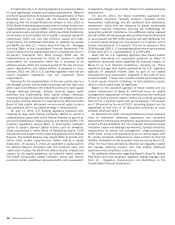Bank of America 2011 Annual Report Download - page 63
Download and view the complete annual report
Please find page 63 of the 2011 Bank of America annual report below. You can navigate through the pages in the report by either clicking on the pages listed below, or by using the keyword search tool below to find specific information within the annual report.Bank of America 2011 61
FDIC Deposit Insurance Assessments
In April 2011, a new regulation became effective that implements
revisions to the assessment system mandated by the Financial
Reform Act and increased our FDIC exposure. The regulation was
reflected in the June 30, 2011 FDIC fund balance and in payments
made beginning on September 30, 2011. Among other things, the
regulation changed the assessment base for insured depository
institutions from adjusted domestic deposits to average
consolidated total assets during an assessment period, less
average tangible equity capital during that assessment period.
Additionally, the FDIC has broad discretionary authority to increase
assessments on large and highly complex institutions on a case
by case basis. Any future increases in required deposit insurance
premiums or other bank industry fees could have an adverse
impact on our financial condition and results of operations.
Recovery and Resolution Planning
On October 17, 2011, the Federal Reserve approved a rule that
requires the Corporation and other bank holding companies with
assets of $50 billion or more, as well as companies designated
as systemically important by the Financial Stability Oversight
Council, to periodically report to the FDIC and the Federal Reserve
their plans for a rapid and orderly resolution in the event of material
financial distress or failure.
On January 17, 2012, the FDIC approved a final rule requiring
resolution plans for insured banks with total assets of $50 billion
or more. If the FDIC and the Federal Reserve determine that a
company’s plan is not credible and the company fails to cure the
deficiencies in a timely manner, then the FDIC and the Federal
Reserve may jointly impose on the company, or any of its
subsidiaries, more stringent capital, leverage or liquidity
requirements or restrictions on growth, activities or operations.
The Corporation’s initial plan is required to be submitted on or
before July 1, 2012, and updated annually. Similarly, in the U.K.,
the Financial Services Authority (FSA) has issued proposed rules
requiring the submission of significant information about certain
U.K. incorporated subsidiaries, including information on intra-
group dependencies and legal entity separation, to allow the FSA
to develop resolution plans. As a result of the FSA review, we could
be required to take certain actions over the next several years
which could impose operational costs and potentially result in the
restructuring of certain business and subsidiaries.
Orderly Liquidation Authority
Under the Financial Reform Act, where a systemically important
financial institution such as the Corporation is in default or danger
of default, the FDIC may, in certain circumstances, be appointed
receiver in order to conduct an orderly liquidation of such
systemically important financial institution. In such a case, the
FDIC could invoke a new form of resolution authority, called the
orderly liquidation authority, instead of the U.S. Bankruptcy Code,
if the Secretary of the Treasury makes certain financial distress
and systemic risk determinations. The orderly liquidation authority
is modeled in part on the Federal Deposit Insurance Act, but also
adopts certain concepts from the U.S. Bankruptcy Code.
The orderly liquidation authority contains certain differences
from the U.S. Bankruptcy Code. Macroprudential systemic
protection is the primary objective of the orderly liquidation
authority, subject to minimum threshold protections for creditors.
Accordingly, in certain circumstances under the orderly liquidation
authority, the FDIC could permit payment of obligations determined
to be systemically significant (e.g., short-term creditors or
operating creditors) in lieu of the payment of other obligations
(e.g., long-term creditors) without the need to obtain creditors’
consent or prior court review. Additionally, under the orderly
liquidation authority, amounts owed to the U.S. government
generally enjoy a statutory payment priority.
Credit Risk Retention
On March 29, 2011, federal regulators jointly issued a proposed
rule regarding credit risk retention that would, among other things,
require retention by sponsors of at least five percent of the credit
risk of the assets underlying certain ABS and MBS securitizations
and would limit the ability to transfer or hedge that credit risk. The
proposed rule as currently written would likely have an adverse
impact on our ability to engage in many types of the MBS and ABS
securitizations conducted in CRES, GBAM and other business
segments, impose additional operational and compliance costs
on us, and negatively influence the value, liquidity and
transferability of ABS or MBS, loans and other assets. However, it
remains unclear what requirements will be included in the final
rule and what the ultimate impact of the final rule will be on our
CRES, GBAM and other business segments or on our results of
operations.
The Consumer Financial Protection Bureau
The Financial Reform Act established the Consumer Financial
Protection Bureau (CFPB) to regulate the offering of consumer
financial products or services under federal consumer financial
laws. In addition, the CFPB was granted general authority to prevent
covered persons or service providers from committing or engaging
in unfair, deceptive or abusive acts or practices under federal law
in connection with any transaction with a consumer for a consumer
financial product or service, or the offering of a consumer financial
product or service. Pursuant to the Financial Reform Act, on July
21, 2011, certain federal consumer financial protection statutes
and related regulatory authority were transferred to the CFPB.
Consequently, certain federal consumer financial laws to which
the Corporation is subject, including, but not limited to, the Equal
Credit Opportunity Act, Home Mortgage Disclosure Act, Electronic
Fund Transfers Act, Fair Credit Reporting Act, Truth in Lending and
Truth in Savings Acts will be enforced by the CFPB, subject to
certain statutory limitations. On January 4, 2012, the CFPB’s first
director was appointed, and accordingly, was vested with full
authority to exercise all supervisory, enforcement and rulemaking
authorities granted to the CFPB under the Financial Reform Act,
including its supervisory powers over non-bank financial
institutions such as pay-day lenders and other types of non-bank
financial institutions.
Certain Other Provisions
The Financial Reform Act also expands the role of state regulators
in enforcing consumer protection requirements over banks and
disqualifies trust preferred securities and other hybrid capital
securities from Tier 1 capital. Many of the provisions under the
Financial Reform Act have begun to be phased in or will be phased
in over the next several months or years and will be subject both
to further rulemaking and the discretion of applicable regulatory
bodies. For additional information regarding regulatory capital and
other rules proposed by federal regulators, see Capital
Management – Regulatory Capital Changes on page 67.




